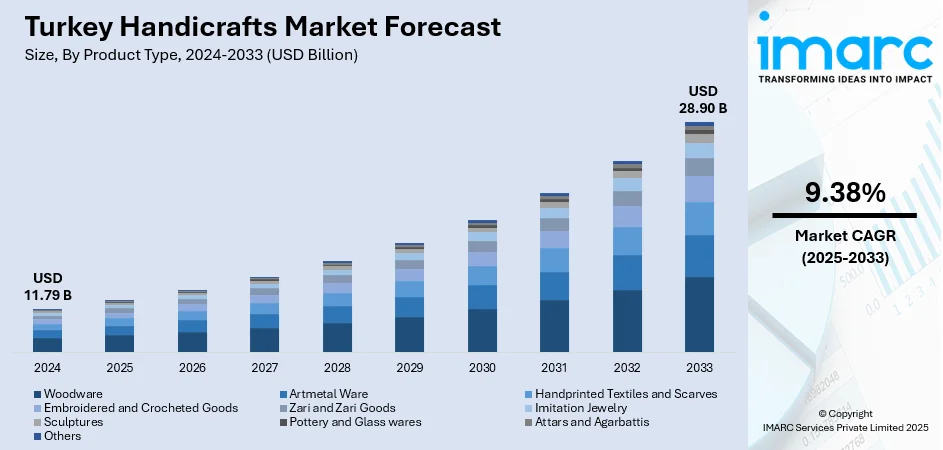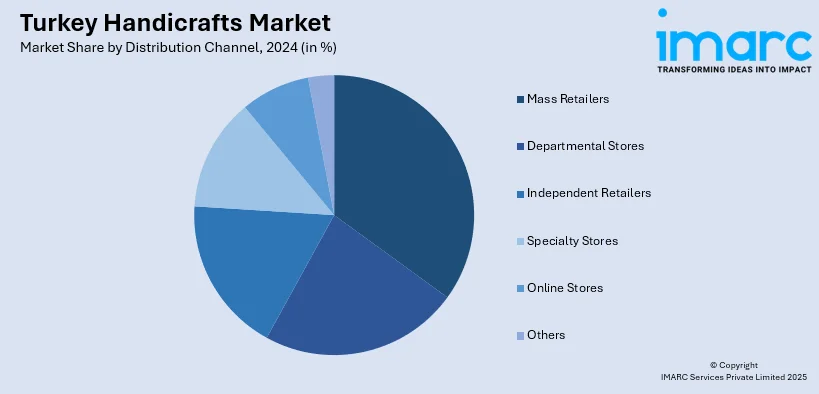
Turkey Handicrafts Market Size, Share, Trends and Forecast by Product Type, Distribution Channel, End Use, and Region, 2025-2033
Turkey Handicrafts Market Overview:
The Turkey handicrafts market size reached USD 11.79 Billion in 2024. Looking forward, the market is projected to reach USD 28.90 Billion by 2033, exhibiting a growth rate (CAGR) of 9.38% during 2025-2033. Growing demand for traditional and cultural goods, rising travel, and a move toward locally produced and sustainable goods are some of the drivers propelling the market. The growth of Turkey handicrafts market share is also attributed to government programs that support artisan crafts and an expanding internet marketplace.
|
Report Attribute
|
Key Statistics
|
|---|---|
|
Base Year
|
2024
|
|
Forecast Years
|
2025-2033
|
|
Historical Years
|
2019-2024
|
| Market Size in 2024 | USD 11.79 Billion |
| Market Forecast in 2033 | USD 28.90 Billion |
| Market Growth Rate 2025-2033 | 9.38% |
Turkey Handicrafts Market Trends:
Cultural Revival and Traditional Craftsmanship
The Turkey handicrafts market growth is significantly influenced by the cultural revival of traditional crafts. Craftspeople all around Turkey are conserving methods that have been handed down through the generations as buyers look for distinctive, historically significant goods. Turkish crafts including woodworking, ceramics, and carpet weaving have become quite popular both locally and abroad. Demand has also been boosted by the popularity of Turkish craftsmanship around the world, which is frequently linked to authenticity and artisanal value. Additionally, the market is being boosted by the growth of cultural tourism, since travelers are keen to buy gifts made locally. For instance, data from the Turkish Ministry of Culture and Tourism shows that Turkey received 62.27 million international visitors in 2024, reflecting a 9.8% rise compared to the previous year. This demand for culturally significant and handcrafted items continues to sustain and expand the Turkey handicrafts market share.

To get more information on this market, Request Sample
Sustainability and Eco-Consciousness
One of the main factors influencing the Turkish handicrafts sector is sustainability. Many consumers are choosing products that promote sustainable practices as a result of growing consumer knowledge of environmental implications. Local craftspeople are adjusting by employing environmentally friendly supplies and practices; they frequently use recycled materials, natural textiles, and age-old processes that leave little environmental impact. This tendency influences consumer behavior and is consistent with a larger worldwide shift towards eco-consciousness. Growth is also fueled by government support for sustainable handicrafts, which includes grants and access to global markets. For instance, Turkey’s Turkish Indian Chambers of Commerce & Industry and Kashmir Chamber of Commerce & Industry (KCCI) agreed to promote Kashmir handicrafts, including silk carpets and pashmina, through trade events and online platforms. Fifty Turkish businessmen were invited to explore investments, with plans for joint ventures in tourism, ceramics, furniture, and textiles. As consumers increasingly prefer environmentally responsible products, the Turkey handicrafts market continues to thrive, with an expanded focus on sustainability.
Turkey Handicrafts Market Segmentation:
IMARC Group provides an analysis of the key trends in each segment of the market, along with forecasts at the region/country level for 2025-2033. Our report has categorized the market based on product type, distribution channel, and end use.
Product Type Insights:
- Woodware
- Artmetal Ware
- Handprinted Textiles and Scarves
- Embroidered and Crocheted Goods
- Zari and Zari Goods
- Imitation Jewelry
- Sculptures
- Pottery and Glass Wares
- Attars and Agarbattis
- Others
The report has provided a detailed breakup and analysis of the market based on the product type. This includes woodware, artmetal ware, handprinted textiles and scarves, embroidered and crocheted goods, zari and zari goods, imitation jewelry, sculptures, pottery and glass wares, attars and agarbattis, and others.
Distribution Channel Insights:

- Mass Retailers
- Departmental Stores
- Independent Retailers
- Specialty Stores
- Online Stores
- Others
A detailed breakup and analysis of the market based on the distribution channel have also been provided in the report. This includes mass retailers, departmental stores, independent retailers, specialty stores, online stores, and others.
End Use Insights:
- Residential
- Commercial
The report has provided a detailed breakup and analysis of the market based on the end use. This includes residential and commercial.
Regional Insights:
- Marmara
- Central Anatolia
- Mediterranean
- Aegean
- Southeastern Anatolia
- Black Sea
- Eastern Anatolia
The report has also provided a comprehensive analysis of all the major regional markets, which include Marmara, Central Anatolia, Mediterranean, Aegean, Southeastern Anatolia, Black Sea, and Eastern Anatolia.
Competitive Landscape:
The market research report has also provided a comprehensive analysis of the competitive landscape. Competitive analysis such as market structure, key player positioning, top winning strategies, competitive dashboard, and company evaluation quadrant has been covered in the report. Also, detailed profiles of all major companies have been provided.
Turkey Handicrafts Market Report Coverage:
| Report Features | Details |
|---|---|
| Base Year of the Analysis | 2024 |
| Historical Period | 2019-2024 |
| Forecast Period | 2025-2033 |
| Units | Billion USD |
| Scope of the Report |
Exploration of Historical Trends and Market Outlook, Industry Catalysts and Challenges, Segment-Wise Historical and Future Market Assessment:
|
| Product Types Covered | Woodware, Artmetal Ware, Handprinted Textiles and Scarves, Embroidered and Crocheted Goods, Zari and Zari Goods, Imitation Jewelry, Sculptures, Pottery and Glass Wares, Attars and Agarbattis, Others |
| Distribution Channels Covered | Mass Retailers, Departmental Stores, Independent Retailers, Specialty Stores, Online Stores, Others |
| End Uses Covered | Residential, Commercial |
| Regions Covered | Marmara, Central Anatolia, Mediterranean, Aegean, Southeastern Anatolia, Black Sea, Eastern Anatolia |
| Customization Scope | 10% Free Customization |
| Post-Sale Analyst Support | 10-12 Weeks |
| Delivery Format | PDF and Excel through Email (We can also provide the editable version of the report in PPT/Word format on special request) |
Key Questions Answered in This Report:
- How has the Turkey handicrafts market performed so far and how will it perform in the coming years?
- What is the breakup of the Turkey handicrafts market on the basis of product type?
- What is the breakup of the Turkey handicrafts market on the basis of distribution channel?
- What is the breakup of the Turkey handicrafts market on the basis of end use?
- What is the breakup of the Turkey handicrafts market on the basis of region?
- What are the various stages in the value chain of the Turkey handicrafts market?
- What are the key driving factors and challenges in the Turkey handicrafts market?
- What is the structure of the Turkey handicrafts market and who are the key players?
- What is the degree of competition in the Turkey handicrafts market?
Key Benefits for Stakeholders:
- IMARC’s industry report offers a comprehensive quantitative analysis of various market segments, historical and current market trends, market forecasts, and dynamics of the Turkey handicrafts market from 2019-2033.
- The research report provides the latest information on the market drivers, challenges, and opportunities in the Turkey handicrafts market.
- Porter's five forces analysis assist stakeholders in assessing the impact of new entrants, competitive rivalry, supplier power, buyer power, and the threat of substitution. It helps stakeholders to analyze the level of competition within the Turkey handicrafts industry and its attractiveness.
- Competitive landscape allows stakeholders to understand their competitive environment and provides an insight into the current positions of key players in the market.
Need more help?
- Speak to our experienced analysts for insights on the current market scenarios.
- Include additional segments and countries to customize the report as per your requirement.
- Gain an unparalleled competitive advantage in your domain by understanding how to utilize the report and positively impacting your operations and revenue.
- For further assistance, please connect with our analysts.
 Request Customization
Request Customization
 Speak to an Analyst
Speak to an Analyst
 Request Brochure
Request Brochure
 Inquire Before Buying
Inquire Before Buying




.webp)




.webp)












